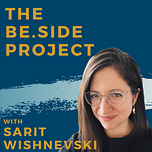In this episode, Holly Blue Hawkins shares about her role in end of life care and advocacy and about the way she came to her work and Judaism.
Heading into the conversation, I expected we would focus on the present day, but it was in the journey that I found myself wanting to stay and listen. It's a reminder that how we get to places is as important as the places themselves.
About Holly Blue Hawkins:
Holly Blue Hawkins is a Natural Deathcare advocate, educator, community organizer, cemeterian, author and poet. As a Gamliel Institute graduate and faculty, member of the Green Burial Council Speakers Bureau, Rosha Chevra Kadisha, past member of the Board of Trustees of the Funeral Consumers Alliance of California, and independent consultant with over 35 years of experience, Holly Blue provides education and training in a wide range of end-of-life subjects in both Jewish and secular settings. She has visited countless natural burial sites from England to Hawai’i and is a regular presenter at Limmud UK in a variety of end-of-life topics. She has trained home funeral guides, consulted with cemetery management and mortuary care center personnel, and taught community college extension courses in all aspects of estate planning and the need for environmentally sustainable and culturally-sensitive practices and facilities.
Hebrew and Jewish References Explained:
Am Yisrael: Hebrew for “the people of Israel” or “the nation of Israel”
Chevra Kadisha: Aramaic in origin is the term for Jewish burial societies, also translated as “holy friends” or “sacred society”
Omer: A period of 49 days between the Jewish holidays of Passover and Shavuot. There is a practice to count each of the days
Shmirah/Shomer: From the Hebrew word “to watch” or “guard”. There is a custom of watch the body of a deceased person from the time of death until burial- this is one of the roles for members of the chevra kadisha
Tahara: The ritual of washing, cleansing, and dressing a body for burial. This is a role of the chevra kadisha














Share this post